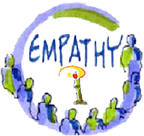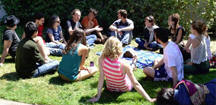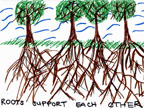|
Learning and Teaching Empathy
Our Challenge.
How might we develop an online empathy
training and curriculum wiki?
What is an empathic way of being?
Teaching Empathy
Magazine
Building, deepening and fostering Empathy - become aware of, articulate and
express feelings.
-
become aware of feelings.
-
name the feelings.
-
have a list of feeling words.
-
notice, describe and express the felt experience in your body.
Express the feelings in a physical way and do mirroring of them.
need a game for children to act out feelings.
Blocks to empathy
Empathy Training
Having an understanding and model for how our biology works.
What are the different models of human nature and how do they effect growth in
empathic way of being?
We can empathize with all kinds of feelings
empathy Wheel
Practices
-
Mutual empathic listening
-
Hearing voices - could they be trained to empathize with each other?
-
breathing exercise - breath for calmness
-
therapy - have a therapist that listens and supports you
-
visualize an ideal compassionate person - imagine actualizing it and acting it
out.
-
Stress - reduction
-
Remembering intention. having an object the holds the caring memory to be
reminded of it.
-
Overview of Teaching empathy
-
Setting the
Intention - Nurturing
an Empathy Way of Being
-
We Are Already in Empathic
Relationship
-
You Can Strengthen the Empathy
Muscles.
-
Believe You Can Strengthen the
Empathy Muscles.
-
thinking you can helps
-
thinking you can hinders
-
The Brain Can Change and Grow
-
Being aware of the components
of empathy
-
Empathic Listening
-
reflection
-
Feelings
-
needs
-
Vicarious Learning
-
Reading Literature
-
Watching Movies
-
Somatic - getting in touch with felt
experiences
-
-
Travel
-
Role playing
-
Stress and Fear Reduction
-
Modeling
-
Service Leaning
-
Study of Literature and the
Arts
-
Storytelling Approaches
-
Go back and rewire old pathways
-
Methods
-
Empathic Listening
- Direct reflective listening based on the work of
Carl Rogers
-
Empathic Design -
-
Nonviolent Communications
- Observations, Feels, Needs Requests model based
on the work of Marshall Rosenberg a student of Carl Rogers
-
Compassionate Listening Project
- Listening,
-
Focusing - empathic
listening to people focusing on their moment to moment felt sense,
based on the work of Gene Gendlin a student of Carl Rogers
-
Psychodrama -
-
Meditation -
-
Empathy Based Processes
Intention
(motivation)
Why do we want to learn empathy?
Why do we even want to raise the level of empathy?
Takes us back to the benefits of empathy in that it feels Damn good,
etc.
Having a social agreement that empathy
is a shared value.
Believing that one can become more
empathic.
The Plastic Brain.
A study at Stanford shows people who believe they can improve their
empathy can versus people who don't believe they can improve it.
It's a natural state
Understanding we are empathizing all time with mirror neurons.
Being aware of the
components of empathy
What parts of the empathic process do we
want to teach?
Layout the individual components of empathy and then show ways to
strengthen each of the parts.
-
Self-Empathy
-
Mirrored Empathy
-
Imaginative Empathy
-
Empathic Creativity
Addressing Specific Parts of Empathy
Stress and Fear
Reduction
We generally have the capacity for empathy. But blocks
get in the way.. If we can remove the blocks, it can open up our empathy.
-
exercise
-
yoga
-
mediation
-
walks
-
etc.
Letting go of Judgments
Empathic Listening
many versions of this.
Role Playing - Imaginative Empathy
Many versions of role taking and perspective
taking. Can just imagine it or go into even deeper role taking by adding
physical props.
Types of role playing. Imaginative empathy.
-
Imagine your are the person, object, etc.
-
Imagine yourself in the future
-
Imagine you are a feeling
-
Imagine and have support material
-
Authors-journalists that take on a deeper role.
-
Actors
Techniques
Modeling
Literature
and the Arts:
Service Leaning
Join or Build an
Empathic Community
Storytelling Approaches
- share your story and students get to know each other and this
overcomes the alienation.
Categories for
Leaning and 'Teaching' Empathy
-
Stress, anxiety, fear reduction
-
Dialogic
-
dialoging with others
-
Empathic Listening
-
a wide var
-
Role playing
-
Acing Improv - yes and
-
Ethnographic interviewing tools
-
Sort
Learn all you can about empathy
-
theory
-
history
-
philosophy
-
science
To empathize with people around
the world, study their culture. Learn about their culture, etc
Empathy Training
|





